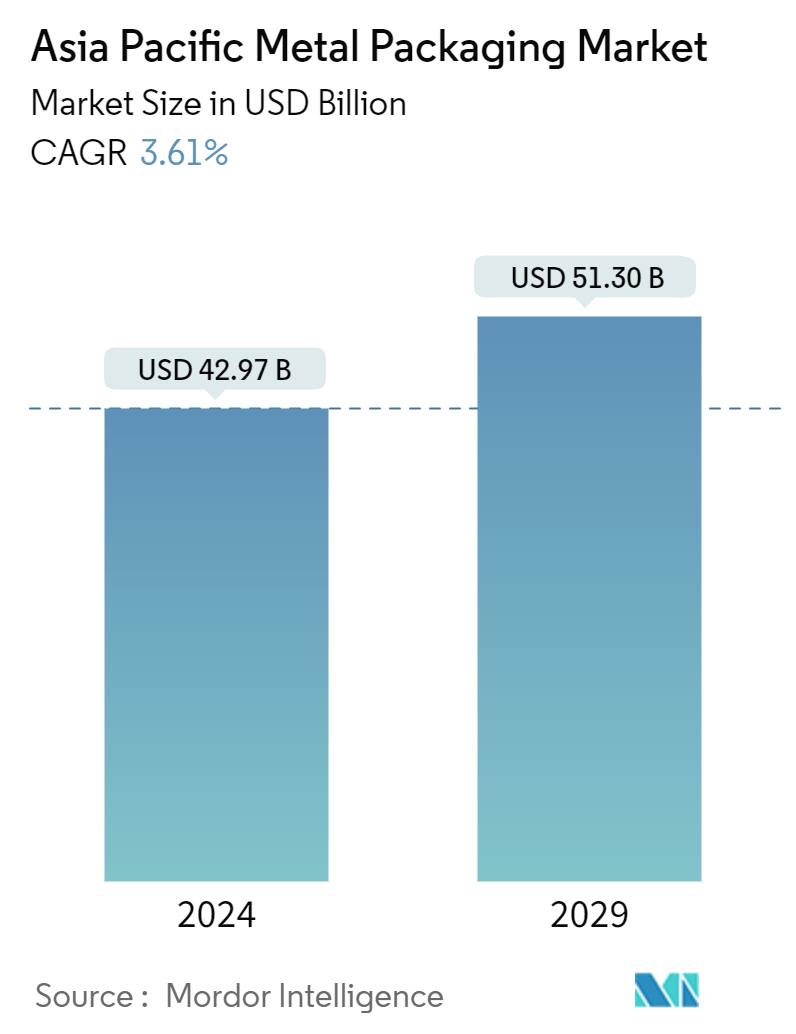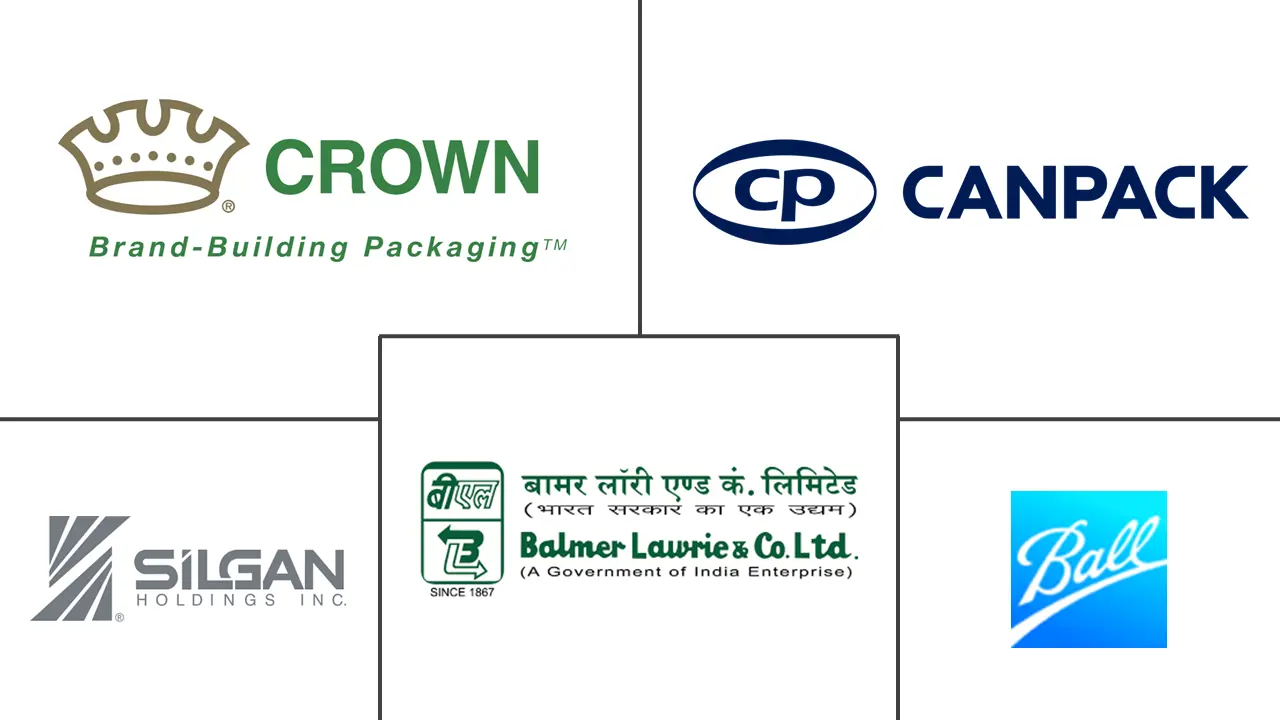Market Size of Asia Pacific Metal Packaging Industry

| Study Period | 2019 - 2029 |
| Base Year For Estimation | 2023 |
| Market Size (2024) | USD 42.97 Billion |
| Market Size (2029) | USD 51.30 Billion |
| CAGR (2024 - 2029) | 3.61 % |
| Market Concentration | Low |
Major Players
*Disclaimer: Major Players sorted in no particular order |
APAC Metal Packaging Market Analysis
The Asia Pacific Metal Packaging Market size is estimated at USD 42.97 billion in 2024, and is expected to reach USD 51.30 billion by 2029, growing at a CAGR of 3.61% during the forecast period (2024-2029).
The Asia-Pacific metal packaging market is projected to register a positive growth rate over the coming years with the increasing adoption of various metal packaging solutions, such as cans and tubes, by various end-user industries in the region.
• The increasing concern among brand owners and consumers regarding sustainability and rising government regulations over the use of sustainable and recyclable packaging products are the major factors driving the demand for metal packaging in the region. In addition to this, the high production of steel and aluminum in the region attracts metal packaging manufacturers to establish their presence in Asia-Pacific countries.
• In July 2023, Orora Beverages announced its partnership with Velox-digital, an expert in the industrial rigid container market. Velox-digital will supply direct-to-shape digital printing solutions for can design and decoration to Orora Beverage. This will help the company meet its strong outlook for growth in the aluminum can market using new technology.
• The changing lifestyle and increasing consumer spending on go-to food and beverage products force food and beverage brands to offer their products in convenient and portable packaging solutions. Metal cans are used by food and beverage brands owing to the benefits offered by metal packaging.
• The need for durable and barrier-resistant rigid packaging solutions for storing and transporting chemicals and paint products in the region is expected to fuel the demand for metal bulk containers. The metal bulk containers are strong and offer durability while also protecting the content from the external environment.
• However, the presence of various alternative packaging materials, such as plastic and glass, may hamper the growth of the market. The imposition of BIS standards for certain metal packaging products, along with the unstable prices of raw materials, is expected to create a challenge for metal packaging manufacturers in the region.
APAC Metal Packaging Industry Segmentation
Metal packaging is gaining popularity in Asia-Pacific due to the environmental benefits offered by metal packaging in addition to quick and easy recycling. The increasing awareness among brand owners as well as consumers and rising government regulations relating to the use of plastic packaging are expected to fuel the growth of the metal packaging market in the region. In addition to the benefits offered by metal packaging products, the rising production of steel and aluminum in the region is projected to drive the sales of metal packaging products compared to other packaging materials among the end-user industries.
The Asia-Pacific metal packaging market is segmented by material type (aluminum and steel), product type (cans [food cans, beverage cans, and aerosol cans], bulk containers, shipping barrels and drums, caps & closures, and other product types), end-user industry (beverage, food, cosmetic & personal care, household, paints and varnishes, and other end-user industries), and country (China, India, Japan, South Korea, Australia and New Zealand, and Rest of Asia-Pacific). The market sizes and forecasts are provided in terms of value (USD) for all the above segments.
| By Material Type | |
| Aluminium | |
| Steel |
| By Product Type | |||||
| |||||
| Bulk Containers | |||||
| Shipping Barrels and Drums | |||||
| Caps & Closures | |||||
| Other Product Types |
| By End-user Industry | |
| Beverage | |
| Food | |
| Cosmetics & Personal Care | |
| Household | |
| Paints & Varnishes | |
| Other End-user Industries |
| By Country*** | |
| China | |
| India | |
| Japan | |
| South Korea | |
| Australia and New Zealand |
Asia Pacific Metal Packaging Market Size Summary
The Asia Pacific metal packaging market is poised for steady growth, driven by the increasing adoption of metal packaging solutions such as cans and tubes across various end-user industries. This growth is largely fueled by heightened consumer and brand awareness regarding sustainability, alongside stringent government regulations promoting the use of recyclable packaging. The region's robust production of steel and aluminum further attracts manufacturers to establish operations in Asia-Pacific countries. Innovations in packaging technology, such as Orora Beverages' partnership with Velox-digital for advanced can design and decoration, are expected to enhance the market's growth trajectory. Despite the challenges posed by alternative materials like plastic and glass, the demand for durable and barrier-resistant metal packaging solutions in sectors such as food, beverage, chemicals, and personal care continues to rise, supporting the market's expansion.
The metal packaging market in Asia Pacific is also significantly influenced by the edible oil industry, where metal containers are preferred for their ability to preserve oil properties and provide a premium packaging solution. The increasing consumption of edible oil, particularly in India, underscores the demand for metal packaging, despite challenges like BIS standards and raw material price fluctuations. In the cosmetics and personal care sector, the demand for aluminum tubes is driven by their recyclability and sustainability, aligning with consumer preferences for eco-friendly products. The region's growing cosmetics market, especially in countries like South Korea, further propels the use of aluminum packaging. However, competition from alternative packaging materials and formats poses challenges to market growth. The presence of both local and global manufacturers, coupled with low entry barriers, intensifies competition, fostering innovation and expansion within the market.
Asia Pacific Metal Packaging Market Size - Table of Contents
-
1. MARKET INSIGHTS
-
1.1 Market Overview
-
1.2 Industry Value Chain Analysis
-
1.3 Industry Attractiveness - Porter's Five Forces' Analysis
-
1.3.1 Bargaining Power of Suppliers
-
1.3.2 Bargaining Power of Buyers
-
1.3.3 Threat of New Entrants
-
1.3.4 Threat of Substitute Products
-
1.3.5 Intensity of Competitive Rivalry
-
-
1.4 Impact of Geopolitical Scenario on the Market
-
-
2. MARKET SEGMENTATION
-
2.1 By Material Type
-
2.1.1 Aluminium
-
2.1.2 Steel
-
-
2.2 By Product Type
-
2.2.1 Cans
-
2.2.1.1 Food Cans
-
2.2.1.2 Beverage Cans
-
2.2.1.3 Aerosol Cans
-
-
2.2.2 Bulk Containers
-
2.2.3 Shipping Barrels and Drums
-
2.2.4 Caps & Closures
-
2.2.5 Other Product Types
-
-
2.3 By End-user Industry
-
2.3.1 Beverage
-
2.3.2 Food
-
2.3.3 Cosmetics & Personal Care
-
2.3.4 Household
-
2.3.5 Paints & Varnishes
-
2.3.6 Other End-user Industries
-
-
2.4 By Country***
-
2.4.1 China
-
2.4.2 India
-
2.4.3 Japan
-
2.4.4 South Korea
-
2.4.5 Australia and New Zealand
-
-
Asia Pacific Metal Packaging Market Size FAQs
How big is the Asia Pacific Metal Packaging Market?
The Asia Pacific Metal Packaging Market size is expected to reach USD 42.97 billion in 2024 and grow at a CAGR of 3.61% to reach USD 51.30 billion by 2029.
What is the current Asia Pacific Metal Packaging Market size?
In 2024, the Asia Pacific Metal Packaging Market size is expected to reach USD 42.97 billion.

